If you're ready to work with voile fabric, you'll need to master specific techniques to handle its delicate, sheer nature. While voile's lightweight drape creates stunning garments, its tendency to shift and fray can challenge even experienced sewists. You'll discover that proper preparation and specialized tools make all the difference between professional results and frustrating mistakes. Let's explore the essential methods that will help you transform this ethereal fabric into beautifully finished pieces.
Key Takeaways
- Use proper needles and set stitch length to 1.5-2.0mm for clean, precise stitches through voile fabric.
- Pre-wash voile in cold water with mild detergent, then press with warm iron while damp before cutting.
- Double the amount of pins typically used, placing them every 2-3 inches to prevent fabric shifting during sewing.
- Create French seams or use rolled hem techniques to achieve professional finishes and prevent fraying edges.
- Stabilize the fabric with tissue paper while cutting and sewing to maintain control and prevent distortion.
Preparing to Sew with Voile
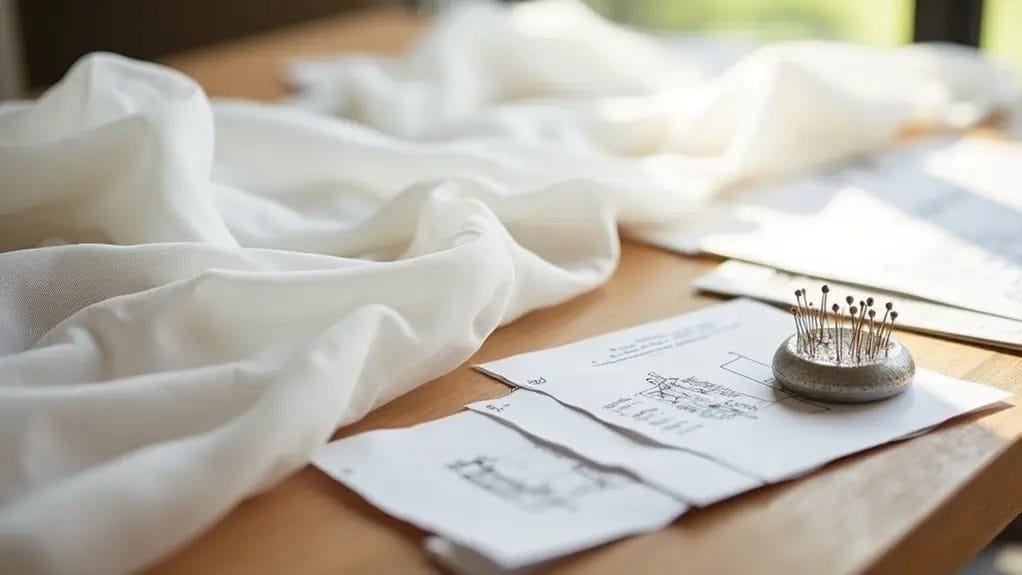
To begin sewing with voile, you'll need to gather essential supplies including extra-fine needles, plenty of pins, tissue paper for stabilizing, and a rotary cutter with mat.
Before cutting your fabric, pre-wash your voile to prevent future shrinkage and ensure accurate sizing in your finished project. Once washed, press your voile with a warm iron while it's slightly damp to remove wrinkles and create a smooth surface for precise cutting and sewing.
Gathering Supplies
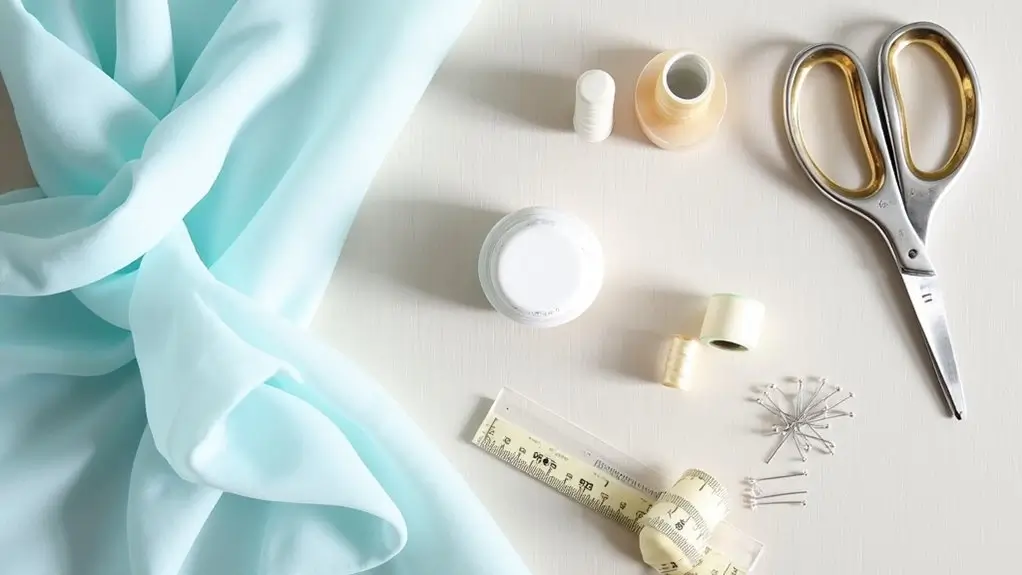
Before sewing with voiles, you'll need essential supplies to ensure professional results. The delicate nature of voile demands specialized tools for optimal handling and construction.
- Smaller needles to prevent fabric damage and ensure clean stitches
- Extra-fine polyester or invisible thread that won't compromise the fabric's sheerness
- Thin fabric clips or additional fine pins to secure layers without distortion
- Fine marking tools like water-soluble markers or chalk for precise lines
Keep these supplies organized and within reach as you sew voile. Having the right tools ready will help you maintain control over this fine fabric throughout your project.
Pre-Washing and Ironing

Since proper preparation prevents poor results, pre-washing and ironing your voile fabric creates the foundation for a successful sewing project.
Begin by soaking your fabric in warm water using a gentle cycle and mild detergent. This step removes sizing and prevents future shrinkage while preserving the fabric's color and delicate nature.
Once washed, iron your voile while it's slightly damp, using a low heat setting. Don't apply steam directly to the fabric, as this can create water spots or distortion.
Work carefully across the fabric to achieve a crisp, smooth finish that'll make cutting and sewing significantly easier.
Tips for Sewing Voile Fabric

To successfully sew voile fabric, you'll need lightweight cotton or polyester thread paired with a thinner needle for optimal stitch formation. Your cutting and pinning must be precise, with pins placed every 2-3 inches to prevent the fabric from shifting during construction. When sewing, maintain even pressure on both fabric layers while using a shortened stitch length of 1.5-2.0 mm, which helps create stable seams in this lightweight material.
Choosing the Right Thread
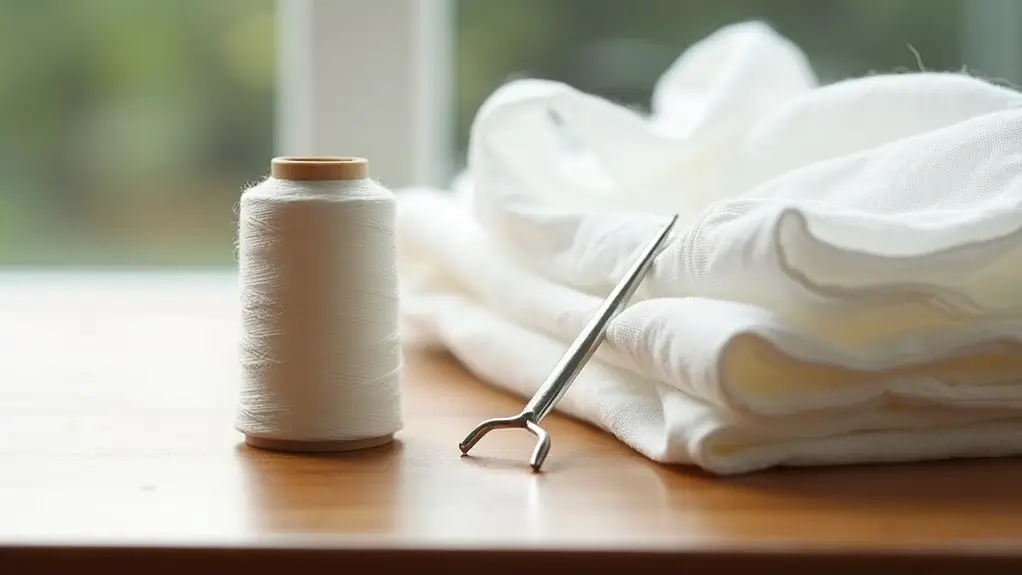
When sewing with voile fabric, choosing the right thread is crucial for achieving professional results. The lightweight nature of voile fabrics demands careful thread selection to ensure your finished garment maintains its elegant drape and professional appearance.
- Select extra-fine cotton or polyester thread (60-weight) to complement voile's lightweight characteristics.
- Consider invisible thread for seams where you want the fabric's drape to be the focal point.
- Test thread tension on fabric scraps before starting your main project.
- Use a shorter stitch length (1.8-2.0) to secure seams and prevent puckering.
Remember that proper thread selection significantly impacts your final results, affecting both the fabric's movement and overall aesthetic appeal.
Needle Selection
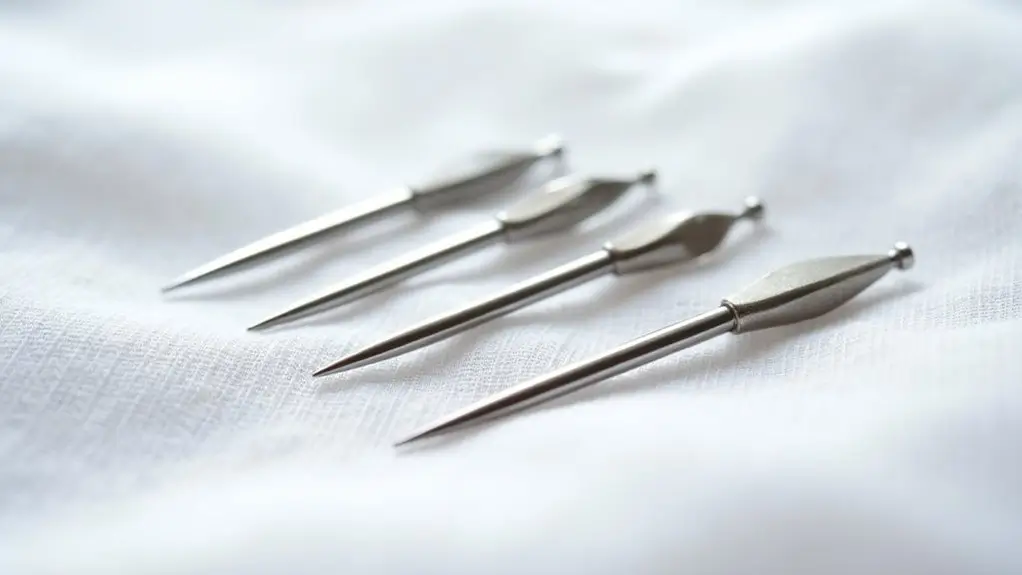
Selecting the right needle stands as a critical factor in successfully sewing voile fabric.
You'll need to use an extra fine needle to prevent snagging the delicate fibers. Choose a smaller size needle to create minimal holes in your voile.
Don't use universal needles, as they'll leave larger punctures that can damage your fabric's appearance and structural integrity.
Since voile's slippery texture requires precise handling, you'll want to replace your needle regularly to maintain optimal performance. This ensures smooth stitching and preserves the fabric's elegant drape.
Sewing Techniques

Successful voile sewing demands specific techniques that accommodate the fabric's delicate nature.
When working with this finer textile, you'll need to adapt your standard sewing methods to ensure professional results.
- Secure your fabric layers with pins placed every 2-3 inches to prevent shifting during sewing.
- Set your sewing machine to a shorter stitch length (1.5-2.0mm) to avoid puckering and ensure stable seams.
- Implement French seams for a clean, professional finish that encases raw edges.
- Use gentle pressure when guiding the fabric through your machine, letting the feed dogs do the work.
These essential sewing techniques will help you master voile's unique characteristics.
Cutting and Pinning Tips
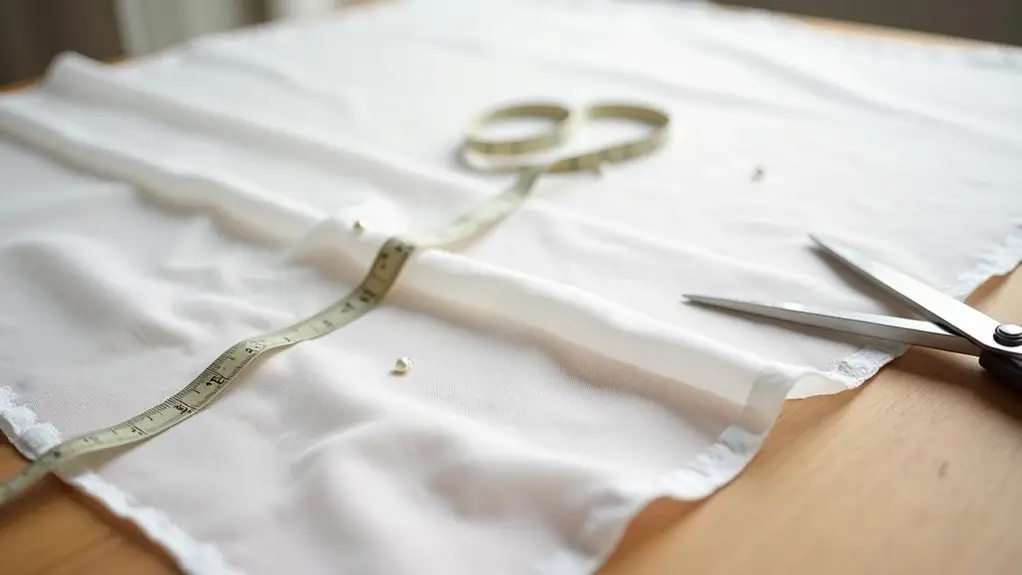
Precise cutting and pinning techniques form the foundation for successfully working with voile fabric. To ensure accuracy, cut your fabric in a single layer using a rotary cutter and mat. Stabilize the material by pinning it to tissue paper or lightweight paper before cutting.
Mark the right side of your voile with painter's tape for easy identification during construction. You'll need to use more pins than usual to secure the fabric properly, preventing unwanted movement while sewing.
Before starting your main project, practice your cutting techniques on scrap pieces to get comfortable with voile's unique characteristics.
Finishing Techniques

When working with voile fabric, you'll need to master specific finishing techniques to ensure professional results.
For seam finishing, you should opt for French seams or bias tape to prevent fraying and create clean edges that complement the fabric's delicate nature.
To achieve polished hems, you can use rolled hem techniques or hand-sewn bias tape applications, which provide excellent control over the lightweight material while maintaining its graceful drape.
Hemming Voile
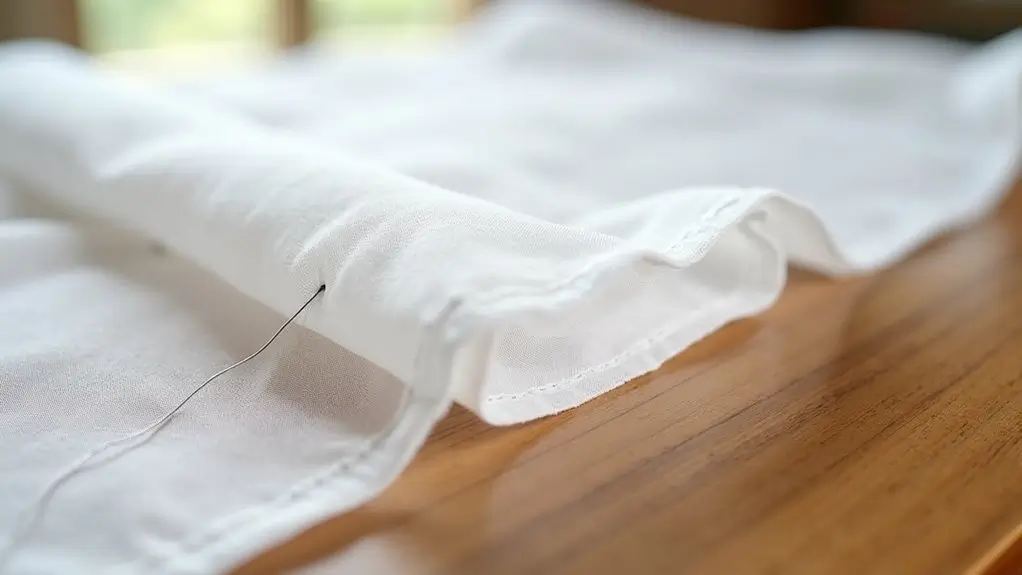
Creating professional hems on voile fabric requires specific techniques to maintain the material's delicate drape while preventing fraying.
When hemming voile, you'll achieve the best results using a rolled hem technique, which creates a refined finish without adding bulk.
- Set up your sewing machine with a narrow hem foot to guide the fabric's edge precisely through the folder.
- Secure edges with a zigzag stitch or serger before folding to prevent fraying.
- Pin the hem using more pins than usual to control the fabric's slippery nature.
- Test your hemming technique on scrap voile to perfect stitch length and tension settings.
Seam Finishing

Seam finishing techniques make a critical difference when working with voile's delicate composition. You'll want to use French seams as your primary finish method, as they fully enclose raw edges and prevent fraying while creating a sophisticated look.
For additional options, try a narrow zigzag stitch or serger finish when French seams aren't practical. These techniques secure the edges while maintaining the fabric's natural drape.
If you're working with curved edges or intricate details, consider hand-sewing bias tape for precise control. Remember that your chosen finish should complement the garment's overall weight and design aesthetic.
Troubleshooting Common Issues
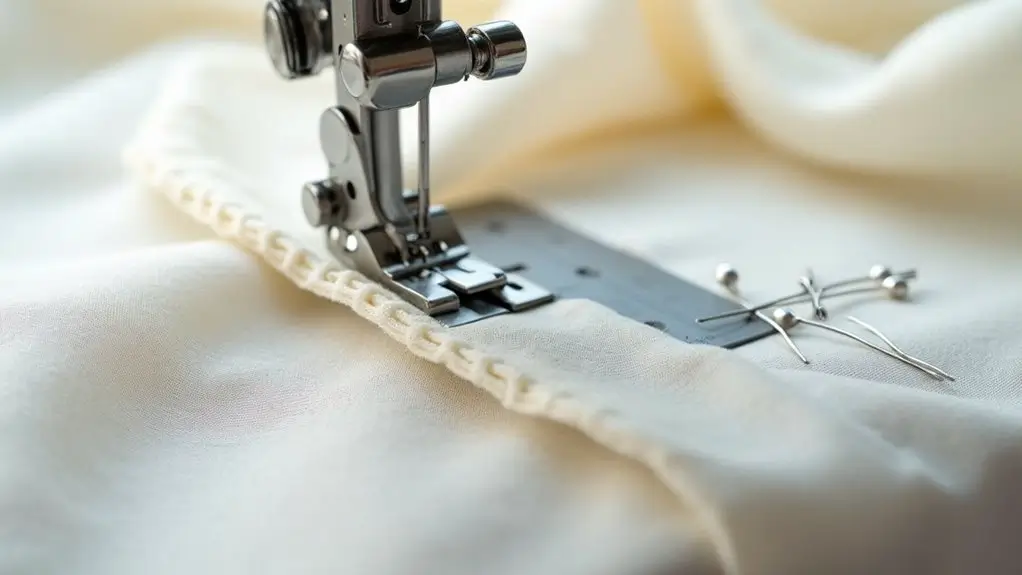
When your voile fabric slips during sewing, you'll need to increase pin placement every 2-3 inches and secure all layers before stitching begins. To control fraying edges effectively, switch to French seams or implement rolled hems using a 1/4-inch seam allowance. If you're experiencing excessive fraying while handling the fabric, apply a light coat of spray starch before cutting and sewing to stabilize the edges.
Dealing with Slipping and Shifting
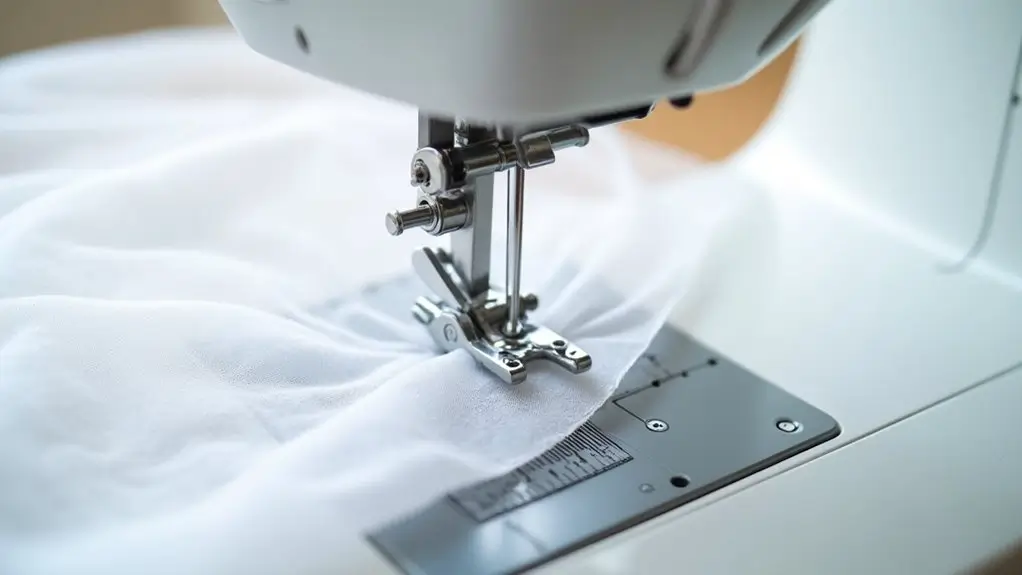
Mastering voile's slippery nature requires specific techniques to prevent fabric shifting during your sewing process. Proper handling begins with stabilization and precise cutting methods.
- Utilize a rotary cutter and mat to achieve clean, accurate cuts while keeping your voile completely flat and stable.
- Double the number of pins you'd normally use, placing them closer together to prevent slipping between fabric layers.
- Apply tissue paper or lightweight interfacing as a stabilizer beneath your fabric while cutting and sewing.
- Reduce your stitch length to 2.0 for improved seam stability and to minimize fabric bunching.
Test these techniques on scrap pieces before working on your main project.
Fixing Frayed Edges

Frayed edges pose a common challenge when working with delicate voile fabric, but several effective solutions can restore and protect your material.
Start by trimming the frayed area cleanly. Then, apply fray check solution along the raw edge. Once dry, reinforce with a narrow zigzag stitch to secure the fabric without adding bulk.
For a professional finish, consider creating a rolled hem or attaching bias tape along the edges. This technique not only prevents future fraying but also adds a decorative element to your project.
Always test your chosen method on a scrap piece first to ensure it works well with your specific voile fabric.
Conclusion
When you've mastered these voile sewing techniques, you'll produce professional-quality garments with clean finishes and elegant drape. Remember to maintain consistent tension, use the correct needle size, and implement appropriate seam finishes. Don't skip the crucial pre-washing step, and always test your settings on fabric scraps first. With proper preparation and technique, you'll transform this lovely fabric into beautifully constructed pieces.


0 comments